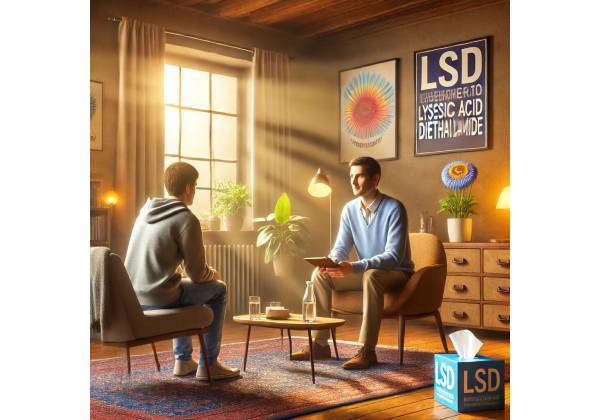
Lysergic acid diethylamide—best known as LSD or “acid”—is celebrated in counterculture lore for mind-bending visuals and spiritual breakthroughs. Yet the same molecule that can unlock creativity may also trap some users in chasing ever-brighter hallucinations, risking psychological turmoil, financial drain, and social isolation. LSD addiction is less about physical withdrawal and more about compulsive pattern-seeking: repeated dosing despite mounting harm. In this in-depth guide, you’ll discover who is most vulnerable, how dependence sneaks in, and practical, research-backed methods to reclaim a balanced, fulfilling life beyond the blotter.
Table of Contents
- Scope of Use and Global Frequency
- Underlying Mechanisms and Vulnerability Factors
- Recognizing Patterns: Indicators and Assessment
- Health Fallout and Psychosocial Costs
- Therapeutic Avenues and Sustainable Recovery
- Common Queries Answered
Scope of Use and Global Frequency
A brief historical lens
Synthesized in 1938 by Swiss chemist Albert Hofmann and famously rediscovered during his 1943 “Bicycle Day” trip, LSD exploded into mainstream awareness during the 1960s. Clinical research in psychiatry, clandestine government trials, and the counterculture movement each played roles in popularizing its use. Mid-1970s legal restrictions shrank medical exploration, yet underground scenes continued, preserving LSD as a staple of raves, festivals, and psychedelic micro-communities.
Contemporary prevalence snapshot
- Youth experimentation: Global school surveys indicate that 2 – 4 percent of high-school seniors have tried LSD at least once, with annual use hovering around 1 percent in North America and Europe.
- Festival micro-chorus: Studies at large music gatherings report past-year LSD use between 15 – 25 percent of attendees, often paired with MDMA or psilocybin.
- Microdosing wave: Tech hubs and creative industries show a climb in sub-perceptual dosing, sometimes two or three times per week. While many users claim productivity boosts, frequency can escalate toward psychological dependence.
- Therapeutic renaissance: Dozens of clinical trials now explore LSD-assisted psychotherapy for cluster headaches, end-of-life anxiety, and depression. Although therapeutic settings are controlled, wider discourse increases general curiosity and unregulated self-experimentation.
Misconceptions about addiction potential
LSD rarely produces classic physical withdrawal, leading some to believe dependency is impossible. However, compulsive psychological patterns—daily microdosing, chasing longer peak trips, or pivoting life around acquisition—fulfill behavioral-addiction criteria. In short, rarity of physical symptoms does not equal immunity to addiction.
Underlying Mechanisms and Vulnerability Factors
Neuropharmacology: why LSD captivates
| System | LSD’s action | Addiction relevance |
|---|---|---|
| Serotonin 2A receptors | Powerful agonism produces altered perception, ego-dissolution, and synesthesia. | Users may crave the insight or escapism this state provides, reinforcing repetition. |
| Default Mode Network (DMN) disruption | Temporary “network reset” linked to feelings of unity and creative thinking. | Some users believe frequent use sustains enlightenment, driving compulsive dosing. |
| Dopamine modulation | Indirect elevation of dopaminergic signaling in reward pathways. | Adds a subtle motivational pull to re-experience the psychedelic high. |
Psychological and personality contributors
| Characteristic | How it fuels repeated LSD use | Practical counter-tool |
|---|---|---|
| Novelty-seeking | Constant desire for fresh sensations makes long trips appealing. | Structured thrill substitutes: rock climbing, improvisational theater. |
| High openness | Intellectual curiosity spurs experimentation with dose, set, and setting. | Channel into new hobbies: foreign languages, musical instruments. |
| ADHD traits | Restless mind may calm during altered-state focus, reinforcing use. | Mindfulness training, appropriate pharmacotherapy. |
| Depression or existential anxiety | Mystical experiences provide transient relief or meaning. | Integrate professional psychotherapy to address root mood issues. |
Environmental magnets
- Psychedelic social media: Forums and influencer testimonials glamorize epic visuals and ego-death transformations, downplaying risks.
- Do-it-yourself microdosing schedules: Online spreadsheets and apps encourage regimented use that can slide from experimentation into dependence.
- Polydrug party circuits: LSD is often part of a weekend cocktail, normalizing frequent use and complicating harm-reduction efforts.
- Easy darknet supply: Blotters, gels, and “liquid acid” shipped discreetly reduce acquisition barriers.
Genetic hints
While direct LSD-addiction genes remain unconfirmed, polymorphisms affecting serotonin transport and dopamine receptors appear in broader behavioral addictions. If immediate family members struggle with substance misuse or compulsive behaviors, personal risk climbs.
Recognizing Patterns: Indicators and Assessment
Behavioral warning lights
- Escalating frequency: Moving from quarterly ceremonies to weekly, then near-daily microdoses.
- Dose intensification: Jumping from 100 µg to 300 – 500 µg to achieve comparable visuals.
- Life scheduling around trips: Avoiding job interviews, family events, or obligations to keep “set and setting” ideal.
- Persistent rumination: Obsessively planning next session or dissecting past trips at the expense of present-moment engagement.
- Neglect of non-psychedelic hobbies: Gradual fading of prior interests that once provided joy.
Cognitive and emotional signals
| Domain | Red-flag experience | Interpretation |
|---|---|---|
| Cravings | Sudden urge to dissolve blotter during stress or boredom. | Psychological dependence cue. |
| Mood volatility | Irritability or dysphoria on non-trip days. | Possible rebound serotonin imbalance; early tolerance. |
| Distorted risk appraisal | Underestimating traffic, heights, or social boundaries while tripping. | Impaired executive monitor due to 5-HT2A overdrive. |
| Ego-inflation or evangelism | Belief that constant LSD use is necessary for enlightenment; preaching to peers. | Ideational fixation tied to dependency. |
Screening tools and professional evaluation
- Psychedelic Compulsive Use Scale (PCUS): Emerging questionnaire measuring frequency, loss of control, and functional impairment.
- Modified DSM-5 behavioral criteria: Tolerance, cravings, time spent, neglected roles, and continued use despite harm.
- Mental-status exam: Check for HPPD (hallucinogen persisting perception disorder), anxiety disorders, or psychosis.
- Medical review: Monitor blood pressure, assess co-ingested substances, and evaluate sleep patterns.
Self-reflection worksheet: Track each LSD session for three months—dose, context, purpose, and after-effects. Add columns for missed obligations and mood the following day. Visual graphs often reveal dependence creep quicker than memory recall.
Health Fallout and Psychosocial Costs
Physiological and neurological complications
| Complication | Description | Likelihood | Mitigation |
|---|---|---|---|
| HPPD | Flashbacks—visual snow, after-images—long after last trip. | 1 – 5 % of users; risk rises with frequent, high-dose use. | Prolonged abstinence; clonazepam or lamotrigine under medical care. |
| Serotonin syndrome | Rare but possible when LSD combined with SSRIs or MAOIs. | Low, yet medical emergency. | Educate about drug interactions; seek immediate care for hyperthermia or confusion. |
| Sleep architecture disruption | Post-trip insomnia or vivid nightmares. | Common with late-night dosing. | Dose earlier, adopt post-trip wind-down routine. |
| Accidental injury | Impaired depth perception leads to falls, burns, or traffic accidents. | Moderate; depends on setting. | Sober sitter, safe environment, avoid driving for 24 h. |
Psychological and cognitive fallout
- Anxiety disorders: Persistent derealization may fuel generalized anxiety or panic.
- Depressive episodes: Serotonin depletion or existential disillusion can trigger low mood weeks after binges.
- Executive dysfunction: Frequent high-dose use may hamper working memory and decision-making skills for months.
- Identity confusion: Over-integration attempts can obscure core values, delaying career and relational commitments.
Social, academic, and vocational impact
- Relationship strain: Partners or family may feel excluded by secretive use or exhausted by trip-centric conversations.
- Academic derailment: Missed deadlines when post-trip fatigue lingers; difficulty concentrating on non-psychedelic coursework.
- Occupational setbacks: Calling in “sick” after marathon journeys; inconsistent performance flagged by supervisors.
- Financial leakage: Continuous purchase of blotters, test kits, specialized playlists, and retreat fees.
Immediate grounding tactic: If intrusive visuals spike at work, place both feet flat, name three solid objects in the room, and breathe out slowly for eight counts. This sensory anchor reduces panic and refocuses attention.
Therapeutic Avenues and Sustainable Recovery
Acute stabilization
- Medical check-in: Rule out serotonin syndrome, dehydration, or sleep deficit.
- Safe environment: Reduce sensory load (light, noise), ensure supportive company.
- Short-term pharmacology: Benzodiazepines for severe agitation (clinical setting only); antipsychotics if acute psychosis emerges.
Evidence-based psychotherapies
| Modality | Key techniques | Best suited for |
|---|---|---|
| Motivational Interviewing (MI) | Resolve ambivalence, elicit intrinsic reasons to change. | Early-stage or curious microdosers. |
| Cognitive-Behavioral Therapy (CBT-PA) | Identify trip-chasing thoughts, restructure expectations, build coping plans. | Individuals with escalating pattern and anxiety co-morbidities. |
| Acceptance and Commitment Therapy (ACT) | Cultivate psychological flexibility, disentangle self-worth from psychedelic identity. | Users facing identity diffusion or existential distress. |
| Mindfulness-Based Relapse Prevention (MBRP) | Train present-moment awareness to surf cravings without acting. | Helpful where triggers are boredom or stress. |
| 12-Step or SMART Recovery groups | Peer accountability, shared language, spiritual reframing. | Those craving community support and structure. |
Pharmacological adjuncts
Research is limited but promising:
- SSRIs/SNRIs: Address underlying depression or OCD-like rumination.
- Lamotrigine: Studied for HPPD visual disturbances.
- N-acetylcysteine (NAC): Antioxidant properties may lessen craving pathways in behavioral addictions—experimental but low side-effect profile.
- Modafinil or stimulant meds: Improve cognition if co-morbid ADHD present.
Always consult a psychiatrist experienced in psychedelic-related care before starting medication.
Daily lifestyle blueprint
- 72-hour reset window: Commit to zero screen time on trip day +2 to avoid overstimulation and allow neurochemical equilibrium to rebound.
- Exercise prescription: At least 150 minutes of moderate cardio weekly; aerobic activity naturally boosts serotonin and dopamine.
- Creative channeling: Use art, journaling, or music to integrate insights without more doses.
- Digital hygiene: Unfollow psycho-influencers, limit forum browsing to scheduled 30-minute windows.
- Social rebalance: Schedule weekly non-psychedelic gatherings—board-game nights, cooking clubs—to rebuild sober joy.
Relapse-prevention scaffolding
- Trigger log: Map cues—stress deadlines, festival announcements, friend group chat notifications.
- Implementation intentions: “If I feel the urge to dose, then I will text my accountability partner and take a 15-minute walk.”
- Monthly reflection: Evaluate progress in finances, relationships, and sleep quality; adjust goals.
- Re-engage passions: Enroll in a course, volunteer, or set fitness milestones to diversify reward sources.
- Gradual exposure to memories: Guided visualization or EMDR can defuse powerful trip flashbacks that lure repeat use.
Long-term outlook
Many people achieve stable abstinence or moderated, intentional use after six to twelve months of layered support. Cognitive clarity, emotional resilience, and regained trust from loved ones often reinforce commitment to change.
Common Queries Answered
Can LSD create physical dependency?
LSD does not trigger classic physical withdrawal, yet psychological cravings, tolerance, and life interference qualify it as a potential behavioral addiction.
How quickly does tolerance build?
Significant tolerance arises after just one high-dose session; repeating the next day often yields diminished effects. Full sensitivity usually returns after about a week, but cravings can push users to escalate doses sooner.
What is HPPD and will it go away?
Hallucinogen Persisting Perception Disorder involves visual disturbances—trails, static, after-images—that linger long after use. Symptoms can fade over months, especially with abstinence and stress management, though some cases require medical treatment.
Is microdosing truly safe?
Low, sub-perceptual doses reduce acute impairments but may still foster psychological dependence and unknown long-term serotonin impacts. Structured breaks and honest tracking are essential.
Can I take LSD if I’m on antidepressants?
Combining LSD with SSRIs often blunts psychedelic effects and raises serotonin-syndrome risk. Always consult a prescribing physician before any psychedelic use.
Are there specific support groups for LSD users?
Yes. Psychedelics-anonymous fellowships, SMART Recovery chapters, and online peer circles focus on hallucinogen misuse. Look for groups emphasizing integration and harm reduction.
Disclaimer
This article is for educational purposes only and is not a substitute for professional medical or mental-health advice, diagnosis, or treatment. Always seek qualified guidance regarding any drug use or psychological concerns.
Found this guide helpful? Please share it on Facebook, X (formerly Twitter), or your favorite platform, and follow us for more science-backed wellness content. Your support helps us keep crafting high-quality resources—thank you!










